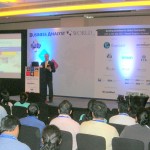Elizabeth and I recently travelled to India to speak and exhibit at two BA World conferences there –  one in Pune and one in Bangalore. The sessions struck us as some of the most interactive presentations we’ve ever given (or attended). Based on the questions and discussions, the attendees seemed knowledgeable, and hungry for more. One participant explained the high level of interaction was that Indian people are competitive and the more they learn the more they will stand out to their employers.
one in Pune and one in Bangalore. The sessions struck us as some of the most interactive presentations we’ve ever given (or attended). Based on the questions and discussions, the attendees seemed knowledgeable, and hungry for more. One participant explained the high level of interaction was that Indian people are competitive and the more they learn the more they will stand out to their employers.
Another participant in the Bangalore event stood out by sending me a recap of key learning points from the 2-day conference. It is a solid listing of the state of business analysis and ways for BAs to excel. Not just in India, but world-wide.
Key Take Aways
Summary written by Ganesh Viswanathan, Senior Business Analyst, Computer Sciences Corporation
I have tried to map the key learning’s into the 3 broad Domain Areas:
Process
1. In today’s complex business environment, a Business Analyst (BA) is expected to be the Change Agent rather than just a Requirements Order Taker!
2. Working in a Virtual Team is always challenging for a BA as we work with multiple Stakeholders across different time zones and culture. Hence, it is becoming imperatively essential to spend time getting to know your virtual team members style, motives and build relationships.
3. Business Analyst should focus on to understand the business problem rather than diving straight into the solution.
4. As the expectations from a BA is expanding due to current economic and challenging market dynamics, the hiring process of a Business Analyst should be refined and defined to meet the business needs.
5. We need to customize our hiring process for BA’s by mapping the role of a BA with the Key Competencies required at various levels with the organization hierarchy. BA Competency Framework needs to be established, mapped, tracked and improved continuously to meet the market and customer demands.
6. Key challenges a BA face in the Agile distributed project environment are, Stakeholder Expectations, Building Relationships, Fear of Failure, and Getting time with the Key Business Stakeholders.
7. The challenges a Agile distributed project bring on to a BA’s shall be effectively overcome by:
- Adopting JIT (Just-In-Time) analysis to drive the maximum from the Agile Sprints
- Organizing face-to-face meeting among the Agile team members
- Setting the Right Expectations during the Inception Phase among the team members
- Building Trust by being Transparent, Committed and Accountable
- Right Tools to automate the day-to-day Operational tasks
People
1. As a BA within the organization, we may not be having the right Authority to take decisions, but by adopting new ways of thinking and style of work, we can be great Influencers with the organization.
2. Key Influencing Tactics a BA shall use:
- Rational Persuasion
- Inspirational Appeal
- Consultation (Watermark’s trusted advisor)
- Personal Appeal
- Forming a Coalition
3. A BA should be able to earn value and power for himself by sharing his/her domain expertise and demonstrating personal leadership qualities.
4. In order to become as great influencer, a BA should develop Credibility and Trust among their team members which shall in turn lead to Success.
5. 3 Steps formula to Influence Without Authority:
- Step1: Building Trust
- Step2: Being Prepared for the Event
- Step3: Being Courageous
6. Business Analysis as a profession is evolving and catching up in the Industry. More and more companies in India have started recognizing the need for quality BA and the value they bring on to the table for a project.
7. BA role is rated as Top professional along with the other IT roles – Forrester Research.
8. As BA’s are considered to be Jack of All and Master of None, the responsibility lies in the individual shoulders to Market and Sell the value of BA within the organization.
9. A BA should set the right expectations; able to articulate the outcomes as similar to an Athlete who defines His/her own expectations, and career path.
10. The BA should treat their fellow team members as partners and collaborate to achieve the business goals and drive the value chain.
Technology
1. Using the Right Tools, at the Right Time, and at the Right Event.
2. BA should understand that it is the Business that should drive Technology and not the other way around.
3. Use the current available Technology to drive and automate the Requirements Elicitation process to provide to the end-users a feeling of What You Need Is What You Get.
4. Simulation technology should be taken advantage wherever applicable to drive visual impact to set a common tone between IT and Business.
Cool Tools
1. SARIE – Situation, Analysis, Recommendation, Implementation and Evaluation. It is not a methodology, but is a framework for performing Business Case Analysis.
2. Organizational Business Analysis Maturity (OBAM) Model
3. Business Analyst Competency Mapping (BACMAP) Framework
4. DISC (Dominant, Influence, Steady, Conscientiousness) Model to understand your team members better and modify the style of work.
===================
Thank you Ganesh, for such a thoughtful and insightful summary!

 New Horizons
New Horizons
 Project Management Academy
Project Management Academy
 Six Sigma Online
Six Sigma Online
 Velopi
Velopi
 Watermark Learning
Watermark Learning
 Login
Login




 New Horizons
New Horizons
 Project Management Academy
Project Management Academy
 Velopi
Velopi
 Six Sigma Online
Six Sigma Online
 Watermark Learning
Watermark Learning